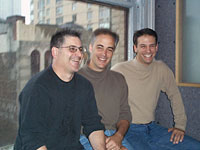
This past spring, three Broadway musicals captured 10 of a combined 36 Tony nominations: Spamalot, Dirty, Rotten Scoundrels and The Light in the Piazza opened within seven weeks of each other, and all were designed by Acme Sound Partners (www.acmesoundpartners.com). Of course, you couldn’t open up a newspaper without seeing some sort of coverage on Spamalot — as the success of Monty Python helped spur on national recognition. However, Acme Sound brings the same amount of attention to detail, professionalism and technical know-how to all of their endeavors — Knights of the Round Table notwithstanding.
Acme Sound’s co-partners, from left: Mark Menard, Tom Clark and Nevin Steinberg
WHO ARE THOSE GUYS?
Acme Sound’s three partners — Tom Clark, Nevin Steinberg and Mark Menard — met when working on Side Show in 1997; Steinberg was the production mixer, Menard was the sound vendor rep for ProMix and Clark was the sound designer. Resulting in a strong partnership, Steinberg was called on to co-design The Full Monty with Clark, which would hit the stage in 2000.
While working on The Full Monty in 1999, Clark was designing for Annie Get Your Gun. As that show was hitting the road, Clark was again called in to sound design Lily Tomlin’s Search for Signs of Intelligent Life. In the midst of working on The Fully Monty and Search for Signs of Intelligent Life, Clark had already committed himself to designing Radio City’s Christmas Spectacular and Jane Eyre, a co-design with Menard.
A year later, Class Act and Bells Are Ringing were the first Acme Sound Partners’ designs with Clark (usually serving as lead sound designer), Steinberg and Menard all contributing.
While there’s no Tony Award for Sound (the one department left out), since winning the 2003 Drama Desk Sound Design Award for the Broadway revival of Puccini’s La Boheme, Acme has gone on to design R-rated puppet musical Avenue Q (winning the 2004 Tonys for Best Musical, Score and Book) and last year’s revival of Fiddler on the Roof, both of which are still running, as are three other Acme Sound designs: The Boy from Oz, Never Gonna Dance and a revival of Gypsy.

Light in the Piazza’s Victoria Clark (Tony winner for Best Actress in a Musical) and Kelli O’Hara
photo: Joan Marcus
SIZE MATTERS
Both Spamalot and Scoundrels — which are within a block of ether other and have similar proscenium theaters — employ the D5T, the theatrical version of the DiGiCo digital console, along with the companion D5Tc theater controller and a D5T RE redundant mix engine, which instantly takes over in case of a malfunction. While the Imperial’s (where Scoundrels is showing) mix position is a dedicated area that takes up no seats, Acme was able to put four Spamalot seats back on sale at the Schubert, which, totaling more than $3,000 a week, could pay for the console in a couple of years. Of course, this economics only applies to sold-out shows.
Though it has double the inputs of a D5 Live, the D5T is the same 41-fader control surface with four LCD touchscreens, but is connected to a 72-bus mix engine with a 32×32 matrix. It has 128 channels, unless onboard output EQ or reverbs are used. Production mixer “Bones” Malone, who uses 115 inputs on Spamalot, describes the board as “the most engineer-friendly of all the digital desks I’ve used.” To save space, his D5T sits sideways in the small 6-foot-square front-of-house area with the D5Tc surface, which Malone does most of the mixing on, facing the stage next to it.
The D5Tc is basically a Go button and a bank of 16 “heads-up” assignable faders or DCAs, whose specific assignments can change from one cue to the next. In practice, faders on each end are always assigned to reverbs, band and drums, with the 10 in the middle changing among performers, depending on who’s onstage. Each cue is written with only actors who have lines, and other mics are muted. Also, as actors move around the stage, delay times and panning are used to align their reinforcement with their acoustical voice, so there are often sub-cues within a scene. “Having a delay on each channel makes that easy to do,” Scoundrels production mixer Bob Biasetti comments. “We used to have racks of XTAs backstage.”
SPEAKERS IN THE HOUSE
Steinberg points out that just prior to Scoundrels, the Imperial hosted The Boy from Oz — another Acme design — and used an almost identical speaker package and the same operator. “This was the first time we used that style of P.A., and we loved it,” Steinberg comments. When Acme returned to the Imperial with Scoundrels, the only major change was the console.
Not only was Acme familiar with the Imperial, but the company had also worked at the Schubert, having designed Gypsy two years prior. Both theaters seat about 1,400, but the Schubert’s mezzanine and balcony are taller, while the Imperial’s are wider. The Schubert’s main array for Spamalot is a nine-box dV-DOSC center cluster that covers a large portion of the audience in all three levels. In the Imperial, Scoundrels has a five-box-wide ARCS center cluster and three-box-high dV-DOSC array just above it that reaches into the balcony’s highest section. “Normally, we like a single shot — front row to back row — with a center cluster,” Menard says.

Dirty Rotten Scoundrels stars (from left) Norbert Leo Butz (Tony winner for Best Performance by a Leading Actor in a Musical), John Lithgow and Sherrie Rene Scott.
photo: Carol Rosegg
Fill speakers at each side of the stage on the orchestra level for Scoundrels are two-box L-Acoustics ARCS arrays turned sideways to provide 60 degrees of horizontal coverage, with 45 degrees of vertical coverage and a high output. Higher up on the proscenium, a single ARCS covers the balcony’s widest sections without having to bounce sound off of the Imperial’s side walls. “At Spamalot, the band fills are pointed up at the ceiling to get ‘bounce’ and provide indirect sound, which is how you naturally would experience the orchestra,” Menard explains. “For Scoundrels, we know orchestrator Harold Wheeler’s material requires more of a direct delivery.”
Another Acme P.A. favorite is the Meyer MSL-2 because of its generous 70×60-degree dispersion, high output, small size and full response. The MSL-2s are used in Scoundrels for orchestra-level down-fills from the FOH electric. These provide a music-only mix that covers orchestra-level seats, which are shadowed by the sunken nature of the pit. For Spamalot, a pair of MSL-2s is also employed for pit-fills; however, they’re aimed up at the Schubert’s ceiling to create dispersion. The MSL-2s are also used as proscenium speakers.
Acme also relies on the d&b E3, a passive speaker with a dedicated amplifier employing a 5-inch cone and a rotatable 60×90-degree horn. “They get quite loud and the fidelity is fantastic,” Clark notes. The E3s are used in all three designs for underbalcony or front-fill speakers.
Surround speakers are used to intentionally bounce sound off the walls. Acme chose EAW JF60 for the job, with the UB-12 a close second. These can be found distributed liberally around side and rear walls on all levels. In the Imperial, the surround speakers are actually firing back toward the ceiling and walls to increase dispersion and reduce localization. “That’s more of a room ‘spatializer’ than anything else,” Menard says. “We don’t want the audience to hear any directivity from the surround speakers; we just want them to feel the space is more alive.”
UPTOWN OPERATIC
About 20 blocks “upstate” to the Lincoln Center’s Vivian Beaumont, The Light in the Piazza has enjoyed commercial success and has been extended through the end of the year, perhaps due to its Tony win. When Mix caught up with the show in late July, production mixer Mark Salzburg was on his first vacation in six months; deck assistant Gary Simon was ably covering the mixing chores on a 64-input Cadac J-Type with a Midas Venice 160 sidecar for the strings.

Spamalot sound mixer Bones Malone
photo: Joan Marcus
The Beaumont is a modern theater with 1,100 seats arranged in a 140-degree half-circle around the stage’s thrust. Here, Acme used five Meyer MSL-2s in the main ring and a pair for music-only down-fills, as well as one on each side for proscenium fills. The balcony is covered with UPA-1Cs from the same catwalk; UPM-1s are over each balcony section. A UPA-1P in the grid and one in each wing are dedicated for the sound effects in the piazza, where there’s also a pair of USW subs and a second pair on the deck.
Acme almost exclusively uses TC Electronic digital reverbs, XTA DSP for speaker management and PRAM for wireless control of XTA’s AudioCore software throughout the venue. “We’ve used a lot of different products from home-grown to rental shop solutions, and we found the PRAM is the best of the bunch,” Menard says. “The WiFi situations in theaters is getting ridiculous. There’s usually several other applications going on at the same time and pretty soon, it’s going to have to be managed.”
They almost always employ Meyer Sound’s SIM for initial room tuning, with Menard performing the operator duties. “The SIM measurements are enormously important to the process, and though we make small adjustments afterward, they’re mostly balancing levels,” Clark explains. “A huge amount of the work is done before the cast is even on the stage.”
Menard has been using SIM since the early ‘green-screen’ days of Version II. “We’ve done shows without SIM’ing, but it provides a great comfort factor,” he comments. “We can have the cast onstage the next day and we know it’s okay.” He points out that SIM provides a robust baseline for the system, that the EQ and delay times rarely change after a SIM session, and it’s usually only adjustments to level that help with imaging. “We could literally walk in and do a show,” he adds

Monty Python’s Spamalot’s Knights of the Round Table, from left: Sir Robin (played by David Hyde Pierce, who is holding the chicken of Bristol), Sir Lancelot (played by Hank Azaria), Sir Dennis Galahad (Christopher Sieber), Sir Bedevere (Steve Rosen) and King Arthur (Tim Curry)
photo: Joan Marcus
This is an enormously important aspect of Acme’s job, or as Steinberg points out, linearity and even coverage are hallmarks of good theatrical design because successful shows don’t allow the designer or operator to listen from any but a few select locations after a show opens. The Acme partners reached an early agreement about the sound designer’s role that Clark calls, ‘You, only louder.’ By this, he means that their job is not to determine how loud the show will get, but to put speakers in place that will reproduce faithfully at all levels. Acme has spirited discussions about equipment choices and their triumvirate approach guarantees both tiebreakers and minority opinions. If two heads are better than one, then three is a bonus.
One extra benefit is that during the hectic rehearsal time between the SIM session and the first preview, there are almost always two Acme partners present: One stays at the console to work with the operator during an incredibly intense period of programming, while the other is free to walk the venue, observing the system’s behavior. A great number of adjustments must be made in a few days, when suddenly costumes, wigs and orchestra appear.
IN THE PIT
In Spamalot, the orchestra is using Hear Technologies personal mixers with Sony headphones or Galaxy HotSpots, while in Scoundrels, they’re using Aviom A-16 mixers. For Piazza, there’s no electronic instruments nor click track, so Acme spent some time arranging the musicians so they could all hear and play acoustically without monitors.
As with their speaker selections, the Acme partners have favorite microphone choices for various applications. The actors’ radio mics are all DPA 4061 miniature lavalieres with Sennheiser SK-5012 miniature bodypack transmitters. A venerable problem-solver for RF is the Professional Wireless Helical Antenna, which appears on all Acme bid lists.

The mischievous knights of Spamalot
photo: Barbara Dicely
DPA mics also are featured prominently in the pit. The 4021 compact cardioid microphone — which has the same capsule as the 4011 with its preamp remoted — is used heavily for woodwinds, string overheads, piano, harp and congas. Their secret weapon for all brass instruments is the 4006 omni condenser. Old-school mic picks on drums include Sennheiser 421s for toms, SM57 for snare and RE-20 on kick. The Aguilar DB900 tube DI is an Acme prize for nylon- or steel-string acoustic guitar, mandolin or banjo, providing natural sound while allowing them to blend with the microphone. “Putting a DI on an electric guitar is a questionable decision to begin with, but this is more usable than a solid-state DI and gives us a warmer sound,” Steinberg points out.
The Acusound miniature gooseneck condenser is used on close-miked strings. The AKG C414 is a workhorse for percussion and acoustic guitar, as are the Neumann U89 and U87 (which have also been used on low reeds).
For sound effects playback, Acme specifies Stage Research’s sound effects software. “SFX is an inexpensive, reliable, graceful program, and everything that it does, it does well. It’s quick and easy-to-use,” Clark comments. “In Lily Tomlin’s Search for Signs of Intelligent Life, there were 380 cues in 90 minutes, and it played six months on Broadway and two more in L.A. flawlessly.”
TAKING IT ON THE ROAD
While Spamalot made its debut on Broadway — and continues to sell out shows in this New York City theatrical hot-spot, it has been in high demand for theatergoers across the U.S. A North American touring production of Spamalot opens next March at Boston’s Colonial Theater; a production in London’s West End is also planned for next year. Other Acme designs taking flight include Avenue Q, which will open in Las Vegas, Anyone Can Whistle at the Ravinia Festival and Irving Berlin’s White Christm as at a theater near you.
Mark Frink is Mix magazine’s sound reinforcement editor. Thanks to Sten Severson, assistant designer for Spamalot, and Jeffrey Yoshi Lee for Scoundrels and Piazza.

Avenue Q
Acme Sound Credits (in alpha order)
A Class Act
Anyone Can Whistle
Avenue Q
Bells Are Ringing
Dirty Rotten Scoundrels
Disney’s On the Record
Dracula: The Musical
Elaine Stitch
Fiddler on the Roof
Flower Drum Song
Gypsy
Harlem Song
Henry V
Irving Berlin’s White Christmas
Jane Eyre
La Boheme
Light in the Piazza
Measure for Measure
Monty Python’s Spamalot
Much Ado About Nothing
Never Gonna Dance
Rshomon
The Boy From Oz
The Full Monty
The Seagull
Thunder Knocking at the Door
Twelfth Night
Twentieth Century
Two Gentlemen of Verona





